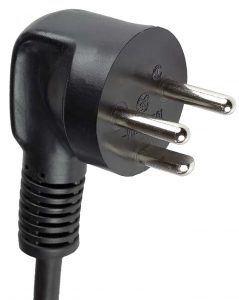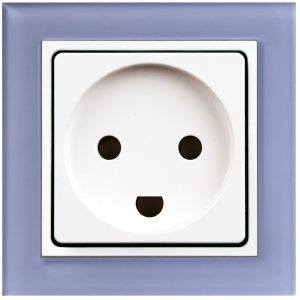TYPE K

 Type K is only used in Denmark and its autonomous territories Greenland and the Faeroe Islands (Click here for the full list of all countries and their respective plugs and sockets.)
Type K is only used in Denmark and its autonomous territories Greenland and the Faeroe Islands (Click here for the full list of all countries and their respective plugs and sockets.)
The Danish standard is described in DS 60884-2-D1. Unlike the similar type E plug, the grounding pin is not mounted in the receptacle, but it is on the plug itself. The U-shaped earthing pin is 14 mm long, 4 mm thick and has a 6.5 mm diameter. The line and the neutral pins of type K are round and have a 4.8 mm diameter. They are 19 mm in length and their centres are spaced 19 mm apart. The centre-to-centre distance between the earth pin and the middle of the imaginary line connecting the two power pins is 13 mm. Or, simply put: the earth pin is offset by 13 mm. The plug is rated at 16 A. A type C plug fits perfectly into a type K socket. The Danish socket will also accept plug types E and F: however, there is no grounding connection with these plugs because a male ground pin is required on the plug.
In the early 1990s, Denmark was forced by the European Union to drop the requirement that all imported earthed electric appliances should be fitted with a type K plug, because it constituted an obstacle to the free movement of goods within the European Internal Market. Ever since that moment, almost all electrical devices in Denmark have been supplied with a type F Schuko plug. The problem with this is that type F plugs are actually not fully compatible with Danish sockets. The plug fits, but the appliance won't be earthed because type K sockets require a male grounding pin on the plug, which type F plugs do not have. That's why many people get a buzzing sensation in their fingers when they touch the dishwasher, the toaster or even their laptop – in the worst-case scenario, it could lead to shocks that might even be life-threatening.
After more than 20 years, the Danish Safety Technology Authority reluctantly decided to finally make it legal to install type F (and even type E) sockets in homes as well. So, the expectation is that, in the long term, the standard European type F socket will eventually replace the Danish type K socket.



